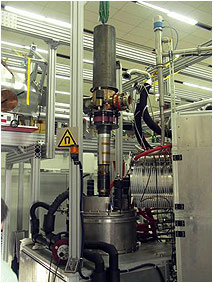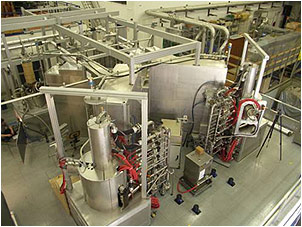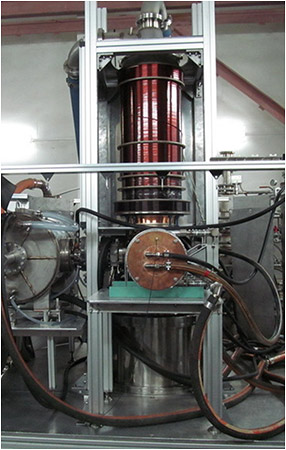 |
|
Gyrotrons for controlled fusion facilities (CFF)
 |
|
|
|
Modern high-popwer gyrotrons for thermonuclear research are capable to generate radiation with a power of up to 1 MW and an efficiency of 40%-50% at frequencies ranging form 30 GHz to 170 GHz in quasi-CW regimes providing pulse durations of up to one thousand seconds. These unique parameters are achieved by using the interaction of a high-power flow of electrons, which move along helical trajectories in a strong magnetic field with high-frequency fields of oversized cylindrical cavities at frequencies being close to the cyclotron frequency of electrons. The working mode in the gyrotron is one of TEmn type cavity mode. Currently, the working modes employed in gyrotrons have high values of azimuthal and radial indexes (m = 25-31 and n=10-17, respectively). The highest-power gyrotrons are equipped with systems for recuperation of the residual energy of the electron beam (depressed collectors), efficient built-in quasi-optical converters of the working mode to the paraxial wave beam, and output windows with disks made of artificial diamond. Due to extremely high thermal conductivity and a very low level of the dielectric loss, diamond windows of gyrotrons can transmit microwaves with a power of over 1 MW in CW regime.
The recent advance in development of the numerical methods of analysis and synthesis of multi-mode electrodynamic systems has allowed one to achieve very high efficiency conversion of high-order working modes to Gaussian wave beams (95%-97%), which is required for operation of a device with a high CW power. The use of depressed collectors not only increases the efficiency up to 50% and over it, but also simplifies the development of power supplies and collector cooling systems.
| |
|
| |
 |
| |
|
The works aimed at further increasing the power and efficiency of gyrotrons go on, and the possibility in principle to achieve even higher powers and efficiencies (up to 1.5-2 MW and 60%, respectively) has been already demonstrated experimentally. Another important direction of developing CFF gyrotrons is the study and development of megawatt-level devices with an option of stepwise frequency tuning. Application of such gyrotrons in plasma CFF could increase the efficiency of systems of electron-cyclotron waves and simplify antenna systems of the facilities.
GYCOM develops gyroresonance devices in close cooperation with the Institute of Applied Physics of the Russian Academy of Sciences (IAP RAS), where the first theoretical and experimental studies of these devices were performed. The IAP RAS/GYCOM cooperation makes it possible to win tenders in competition with such well-known manufacturers as Toshiba (Japan), CPI (USA), and Thales (France). As a result, over 60 Russian gyrotrons have been delivered and installed in facilities of the "tokamak" and "stellarator" types in leading thermonuclear research laboratories of the world. Their application yielded scientific results of fundamental importance, specifically, among others, suppression of plasma instabilities (Asdex-Upgrade tokamak (Germany), see Figs. 1 and 2) and maintenance of the discharge during one hour (LHD stellarator, Japan).
Recently, the joint GYCOM/IAP RAS team has developed a 170 GHz/1 MW/50%/1000 s gyrotron within the framework of the ITER Project (see Figs. 3 and 4).
List of CFF gyrotrons delivered by GYCOM to customers
Name, facility, country |
Gyrotron parameters |
Year of delivery |
Number of gyrotrons |
Т-10, Kurchatov Institute, Russia |
140 GHz, 500 kW, 0.5 s |
1995-1998 |
4 |
129 GHz, 700 kW, 0.5 s |
2000 |
2 |
140 GHz, 750 kW, 0.5 s |
2006 |
1 |
140 GHz, 1000 kW, 10 s |
2007 |
2 |
| T-15MD, Kurchatov Institute, Russia |
82,6 GHz, 1000 kW, 30 s |
2019 |
1 |
| 105 GHz, 1000 kW, 30 s |
2024 |
1 |
L-2M Prokhorov General Physics Institute (Russia) |
75 GHz, 800 kW, 0.1 s |
2006 |
1 |
72/75/78 GHz, 800 kW, 0.1 s |
2007 |
1 |
| Russia |
54,5 ГГц, 800 кВт, 0,05 с |
2023 |
1 |
W-7AS, IPP, Germany |
140 GHz, 800 kW, 0.,5 s |
1993 |
1 |
140 GHz, 500 kW, 3 s |
1994-1997 |
3 |
140 GHz, 800 kW, 1 s |
1997 |
1 |
ASDEX, IPP, Germany |
140 GHz, 500/700 kW, 2/1 s |
1996-1999 |
4 |
140/105 GHz, 1000/800 kW, 10 s |
2006-2018 |
8 |
| TEXTOR, Germany |
140 GHz, 800 kW, 10 s |
2003 |
1 |
TJ-II(U), CIEMAT, Spain |
28 GHz, 400 kW, 0.1 s |
1993 |
1 |
53,2 GHz, 400 kW, 0.3 s |
1998 |
2 |
28GHz, 500 kW, 0.3 s |
2009 |
1 |
FTU, ENEA, Italy |
140 GHz, 500 kW, 0.,5 s |
1993-1995 |
5 |
TCV, SPC (CRPP), Switzerland |
82,6 GHz, 500 kW, 2 s |
1995-1998 |
7 |
| 82,6 GHz, 750 kW, 2 s |
2015-2016 |
2 |
| F4E, Switzerland |
170 GHz, 1000 kW, 1000 s |
2018 |
1 |
D-III D, GA, USA |
110 GHz, 1000 kW, 2 s |
1995-1997 |
3 |
TdeV, Canada |
110 GHz, 400/800 kW, 5/2 s |
1998-2000 |
2 |
CHS, NIFS, Japan |
53,2 GHz, 400 kW, 0.,1 s |
1993 |
1 |
106 GHz, 500 kW, 0.1 s |
1995 |
1 |
54,5 GHz, 500 kW, 0.1 s |
2005 |
1 |
Heliotron-E, Kyoto Univ., Japan |
106 GHz, 500 kW, 0.1 s |
1996 |
1 |
70 GHz, 500 kW, 0.1 s |
2001 |
1 |
| 70 GHz, 500 kW, 0.5 s |
2013 |
1 |
TRIAM-1M, Kyushi Univ., Japan |
170 GHz, 250 kW, 5 s |
2000 |
1 |
LHD, NIFS, Japan |
86,2 GHz, 500 kW, 2 s |
1999-2002 |
4 |
84 GHz, 800 kW, 3 s |
2002-2003 |
3 |
84 GHz, 200/500 kW, CW/10 s |
2003 |
1 |
| 56 GHz, 400 kW, 1 s |
2019 |
1 |
FOM, the Netherlands |
110 GHz, 500 kW, 0.2 s |
1994 |
1 |
SST-1, IPR, India |
82,6 GHz, 200 kW, CW |
2004 |
1 |
| 42GHz, 500 kW, 0.5 s |
2012-2021 |
2 |
ITER-India |
170GHz, 1000 kW, 1000 s |
2021 |
1 |
| HL-2A, SWIP, China |
68 GHz, 500 kW, 1.,5 s |
2005-2008 |
6 |
| 140 GHz, 1000 kW, 3 s |
2012 |
2 |
| 105 GHz, 1000 kW, 3 s |
2015-2017 |
5 |
SWUST, China |
83 GHz, 100 kW, 10 s |
2011 |
1 |
| EAST, ASIPP, China |
140 GHz, 1000 kW, 1000 s |
2014-2018 |
2 |
| 140 GHz, 700 kW, 3000 s |
2019 |
1 |
| 140/105 GHz, 950/800 kW, 1000 s |
2021-2024 |
3 |
| 170 GHz, 1000 kW, 1000 s |
2024 |
1 |
| J-TEXT, HUST, China |
105 GHz, 500 kW, 1 s |
2019-2021 |
2 |
| Qingdao Blue Water quantum technology development company ltd., China |
140 GHz, 1000 kW, 1 s |
2019 |
1 |
| KSTAR, NFRI, Korea |
140/105 GHz, 950/800 kW, 300 s |
2015-2020 |
4 |
| 170 GHz, 1000 kW, 1000 s |
2021 |
1 |
| IN2P3, France |
60 GHz, 300 kW, 0.1 s |
2012 |
1 |
ITER, France |
170 GHz, 1000 kW, 1000 s |
2017-2024 |
8 |
|










